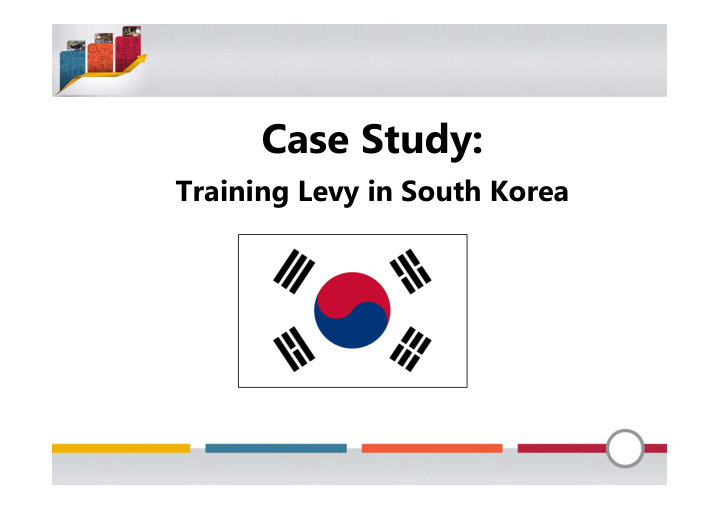



Case Study: Training Levy in South Korea Concepts
Small and Medium Enterprises (SMEs) in South Korea SMEs represent: 99% of all enterprises • 88% of all employment • Training levy system • introduced in 1995 Source: World Bank • Goal: Encourage enterprises to undertake voluntary worker training programs that improve productivity 2 21/06/2017
How does the Training Levy work? 1. Enterprises pay training levy of average $1,000 USD (size dependent) 2. Enterprises undertake worker training programs and submit a claim to government 3. Government pays back enterprises through training rebates for the costs incurred • 100% for large enterprises • 270% for SMEs 3 21/06/2017
Regressive Impact on SMEs Table 1: Comparison between large enterprises and SMEs (1995) SMEs Large Total Training Levies Rebated (rate) 15% 30% Enterprises Participating in Training 4.7% 78% Workers Participating in Training 4% 38% Workers Paying Levy (through 4.5 m 2.4 m 6.9 m enterprises’ contribution) Workers Receiving Training Rebate 0.2 m 0.9 m 1.1 m Source: Lee & Kim (2004) 4 21/06/2017
Group Activity The Problem: • SMEs are the ones who need the most support in training activities • SMEs are paying the training levies but not actively participating or benefiting from the levy-rebate programme 5 21/06/2017
Group Activity Why are SMEs not participating in the programme? Question 1: 10 minutes 6 21/06/2017
Group Activity Debriefing 1. Why are SMEs not participating? 7 21/06/2017
Group Activity How can the policy intervention be re-designed to better serve SMEs? Question 2: 20 minutes 8 21/06/2017
Group Activity Debriefing 2. How would you re-design the policy intervention? 9 21/06/2017
Recap: Main Barriers to SMEs’ Participation Information Administration Human Resources Others? Financial Organization/Scale 10 21/06/2017
What did South Korea decide to do? SME Training Consortiums Launched by: pilot launched in 2001 • Public funds to hire shared Training Managers for groups of SMEs • Pilot in 3 cities: Busan, Implemented by: Incheon, and Kwangjoo 11 21/06/2017
How do Training Consortiums work? • Local KCCI groups together 30-50 SMEs in the same area and industry • Provides funding to hire two shared Training Managers per group • Operating Committee: SME members, local KCCI Chamber, Ministry of Labour field office, and training experts • Training topics: management, accounting, tax administration, financial, technical, etc. 12 21/06/2017
Training Consortiums Pilot Results Table 2: Comparison of SMEs before and after the Pilot SMEs Before Pilot SMEs After Pilot (2001) (2002) Training Levies Rebated 24% 48% (rate) Enterprises Participating in 11% 50% Training Workers Participating in 3,087 (planned) 6,573 (actual) Training # of Training Consortiums 0 3 # of SMEs in Training 90 (planned) 240 (actual) Consortiums # Training Managers in a 0 2 Training Consortium Source: Lee (2006) 13 21/06/2017
Training Consortiums Pilot Evaluation A 2002 survey of what employers said... 72% 81% Waste and defective Improved workers’ products declined job performance and productivity 67% 88% Savings in Factory machinery maintenance and utilization increased repair expenses 14 21/06/2017
Country Wide Implementation of Training Consortiums Table 3: Expansion of SMEs Training Consortium Program 2001 2002 2003 2004 2005 2006 2007 Number of Training Consortiums 6 8 19 30 47 57 69 (Cumulative) Workers Trained (‘000) 4 10 20 38 71 143 295 Number of SMEs (‘000) 1 3 8 15 33 63 134 Levies Rebated 3.2 6.1 14.1 16.8 39.9 45.0 74.4 (Billion Won) Source: Ministry of Labor (2006) 15 21/06/2017
Formation of Training Consortiums Pilot Adaptation – 3 Modalities Private Training Large Buyers and Providers Universities 1 1 2 3 16 21/06/2017
Recap: Timeline of Training System in South Korea 1995 1998 2001 2003 2005 • Obligatory in- • Employment • SME Training • Country-wide • Added new plant Insurance Act Consortiums expansion of ways of vocational of 1998 Pilot the Training forming training launched Consortiums Training Consortiums • Introduced a • Levy- levy-grant • 3 cities: • Changes to exemption system Busan, admin and • 3 ways: KCCI, system Incheon, and procedures universities Kwangjoo and lead • Deregulation buyers, • Operated to allow • 8,000 SMEs training through more private • 240 SMES and 20,000 institutes employment training and 6,500 workers insurance institutes to workers participated offer courses participated 17 21/06/2017
Innovations and Adaptations 1. Stable funding from Employment Insurance Fund 2. Implementation by private sector (KCCI) 3. Shift to market-oriented training services (more relevant to SMEs needs) 4. Reimbursement provided at time of approval of training rather than after 5. More support for in-plant and on-the-job training, including mobile training 18 21/06/2017
Lessons Learned 1. Need a differentiated approach to training based on enterprise size 2. Active involvement of private sector in implementation was a key to success 3. Ensure homogeneity of SMEs, loss of consoritum benefits if too diverse 4. SMEs must have an active role in the organization and management of Training Consoritums 5. Provide adequate number of Training Managers to ensure quality and tailored support 6. Minimize bureaucracy and red tape 19 21/06/2017
Discussion • What do you think about the Training Consortiums approach in South Korea? • Is it enough to solve the barriers to SMEs’ participation? • Can this approach be adapted to other countries? 20 21/06/2017
References • World Bank (2009) : Productivity Increases in SMEs: With Special Emphasis on In-Service Training of Workers in Korea • Ministry of Employment & Labour and KDI School (2014): In-Service Training Policy in Korea 21 21/06/2017
Recommend
More recommend